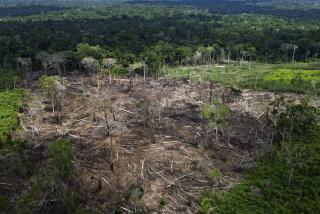Prelude to a Forest Journey
The destruction of the world’s forests is one of the major concerns of our age. Each year the world loses about 37 million acres of forests. According to United Nations’ estimates, nearly 40% of Central America’s forests were destroyed between 1950 and 1980. During the same period, Africa lost 23% of its forests and the Himalayan watershed 40%.
The problems associated with deforestation include depletion of firewood supplies (still the primary source of energy for 2 billion people, or three-quarters of the population of the developing world), severe flooding, accelerated loss of soil, encroaching deserts, and declining soil productivity.
In many parts of the developing world these problems have assumed disastrous proportions. Fuel wood shortages plague 57 developing countries, adversely affecting more than a billion people. Torrents from monsoons pouring down deforested Himalayan slopes kill thousands in India and Bangladesh every year. Denuded Nepal’s biggest export is its soil, which falls into rivers at an alarming rate and ends up in the Indian Ocean. Many scientists suspect that the spread of the Sahara Desert and the resulting famine in countries of western Africa have been brought about, at least partially, by deforestation. A further consequence of rapid deforestation can be seen in Haiti, where a continual decrease in the amount of arable land has resulted in smaller harvests even as the population grows--no doubt a prescription for disaster.
The worst has yet to come. If the current rate of deforestation continues unabated, much of the world’s remaining tropical forests will disappear by the year 2000, and with them, many of the Earth’s plants and animals. The loss of these forests will create an energy crisis for 2 billion human beings who will lack sufficient quantities of wood with which to cook their meals and heat their dwellings. In their desperate search for fuel, they will destroy more distant forests, thereby accelerating erosion, climatological changes, and desertification, and possibly bringing about widespread famine.
People living in the developed world face an equally catastrophic future if worldwide deforestation continues. New research suggests that the loss of forests exacerbates the greenhouse effect, which is caused by carbon dioxide, emitted by burning fossil fuels, building up in the atmosphere and retaining solar heat that would otherwise escape, resulting in global warming. Leaves of trees, on the other hand, absorb carbon dioxide, removing it from the atmosphere. Adapting to such global climatic changes will prove costly, especially for the mid-latitude regions of the Northern Hemisphere, where it is predicted that drying trends will severely cut crop yields. Furthermore, the cure for dreaded diseases such as AIDS and cancer may reside in some plant as yet undiscovered that grows in the rain forest--if destroyed, humankind will be forever denied such help.
The future state of the world’s forests, especially our tropical forests, seems so bleak that one commentator rues, “There appears to be no way civilization and rain forest can share space; the former devastates the latter.” John Perlin’s new book, “A Forest Journey: From Mesopotamia to North America” (W. W. Norton: $19.95) shows us that we can delete the word rain and this statement rings true whenever and wherever civilizations have risen and flourished.
Sadly, the present assault on our forests, as Perlin chronicles so ably, is part of the same cycle begun thousands of years ago. Every Old World starts out as virgin land attractive to human settlement. Subsequent exploitation by humans wears out the land, forcing them to move on to their next “New World.” This quest for new frontiers, which many have thought peculiar to the American experience, is but a repetition of an age-old process that has occurred again and again in the course of time, beginning in Mesopotamia more than 5,000 years ago and continuing today. But “A Forest Journey” does not merely prophesy disaster. It also presents hope: that we can learn from past mistakes and break out of the cycle of deforestation and land degradation that undermined earlier civilizations.
“A Forest Journey” is more than just a chronicle of devastation. It describes the movement of Western civilization in a most unique and fascinating manner. The book takes one resource, wood, the principal building material and fuel of past societies, as its starting point, showing how wood served past societies and demonstrating its influence on their behavior.
Perlin shows, for example, that the urgent need to find new sources of wood has been an important cause--insufficiently noted--of large population movements throughout history. England’s attraction to North America during the 17th and 18th centuries was in great part due to the paucity of its own timber supply and an awareness of the great store of trees in the New World. Similarly motivated colonization movements had already occurred in more ancient times. One of the chief reasons the Romans colonized Gaul and Spain was to take advantage of the abundant forests they could use to fuel mining operations and industries.
Scarcities of wood also have triggered major technological changes and advances. Insufficient quantities of fuel forced Late Bronze Age metallurgists on the island of Cyprus to develop many ingenious methods of conserving energy: For instance, they recycled scrap bronze to reduce their consumption of wood. Eventually, acute shortages of wood impelled these metalworkers to manually remove iron from copper slag, resulting in an important human step, our entry into the Iron Age. Wood shortages in ancient Greece and Rome taught architects to exploit solar energy. Thousands of years later, the scarcity of timber forced the English to enter the fossil fuel era, substituting coal for wood as the principal fuel.
Wood scarcities have forced governments to take an active role in the allocation and protection of this precious resource. Hammurabi, the great codifier of laws in Babylon, saw to it that government officials regulated the felling of timber and the distribution of its end products so as to put a stop to the profligate use of wood by his subjects. Authorities on wood-less Delos in Hellenistic times monitored the sale of imported firewood and charcoal, believing that the distribution of such valuable sources of energy should not be controlled by a few powerful fuel merchants, who otherwise would have had consumers at their mercy. To ensure the availability of sufficient quantities of firewood for those living in Rome, the government commissioned an entire fleet of ships for the sole purpose of gathering wood from the dense forests of France, Spain, and North Africa. The Venetian Senate of the 15th and 16th centuries passed a number of laws aimed at protecting its dwindling forests, as did the English Parliament of the 16th and 17th centuries.
Before 1900 BC Crete was merely another island in the Aegean, until its rich forests attracted traders from the deforested area of Mesopotamia. The commerce in wood between Crete and the Near East injected such wealth into the economy that Crete was transformed swiftly into one of the region’s most powerful states. Likewise, Macedonia, an insignificant backwater country on the fringes of the Greek world, became the immensely rich and influential power of the Mediterranean after the Greeks had exhausted their own supplies of wood and had come to depend on Macedonia’s forests for fuel and building material. The Macedonians soon translated their wealth into political and military power, resulting in the conquest of nearly the entire known world by their king, Alexander the Great. Millennia later America’s untouched forests laid the foundation for its allure as the land of opportunity.
Conversely, lack of wood has brought about the economic and social decline of civilizations when alternative wood sources could not be found. Once the Classical Greek states lost their hold on accessible supplies of timber, they became subservient to wood-rich Macedonia. England, by contrast, forestalled decline by developing its coal resources.
The causes and objectives of many wars and revolutions become clearer when we take the presence or absence of wood supplies into account. The Athenian Empire and the Peloponnesian League fought for possession of northern Greece and Sicily’s forests. Conflict over rights to timber between the American colonists and Great Britain helped lead to revolution. England reserved America’s best stands of trees for its navy while the Americans wanted the freedom to cut down whatever woods they wished. Without its wood resources, America’s bid for independence would surely have failed. All of America’s ships were built locally and there was an abundance of charcoal to produce iron for weaponry.
Ecologically concerned voices are loudest and most heeded when important resources such as wood appear to be on the verge of depletion. Plato vividly warned the Athenians in the Critias of the consequences of deforestation. Cato taught the Romans the best ways to husband their scarce wood supplies. Many years later, John Evelyn campaigned to save the few remaining forests in Stuart England, writing his famous conservation tract, “Sylva.” The destruction of America’s great Eastern forests served as the stimulus for the development of American ecological concern.
Deforestation throughout history has left soil at the mercy of the erosive forces of nature. Formerly productive lands turned into sterile, drought-plagued regions. Famine ensued, bringing down powerful and prosperous societies. Stripped of its forest cover, the magnificent civilization of Knossos declined. Such a change in vegetation and soil conditions assured that this region would never again support the population or enjoy times as prosperous as it had in its “Golden Age” when Cretan power held sway over much of the eastern Mediterranean. The loss of soil on deforested hillsides also caused a sharp decline in agricultural production in the great Mycenaean Kingdoms of Bronze Age Greece, resulting in reduced crop yields, impoverishment, and depopulation of the area. Rome, too, came to depend on others for food when its farmlands were cleared on the tree cover that had nourished the soil for ages.
Throughout “A Forest Journey” we see a similar process repeated time and time again. Blessed by easy access to forests and rich soil, a society develops materially and people grow confident that nature will always provide for their needs. Prosperity and population invariably increase for a time. The faster an area develops demographically and economically, the greater are its demands on the remaining forest and agricultural lands. To ensure the continued flow of adequate amounts of wood and food, societies rely on colonization, diplomacy, and military ventures. Ultimately, however, the attempt to maintain high economic and population growth over time, in the face of dwindling resources, results in decline. Substitute wood for oil in today’s world and the parallel becomes sobering.
These are just glimpses of what’s in store for the reader of “A Forest Journey.” Each page is replete with valuable information on the important role that wood played through the ages--its influence on the development and decline of societies through judicious use or depletion of this valuable resource. The book is a treasure trove of knowledge. In my opinion, “A Forest Journey” is destined to become a classic and stand alongside such important works as George P. Marsh’s “Man and Nature” and Ken Butti and John Perlin’s “A Golden Thread.” What’s more, “A Forest Journey” makes great reading.
More to Read
Sign up for Essential California
The most important California stories and recommendations in your inbox every morning.
You may occasionally receive promotional content from the Los Angeles Times.










